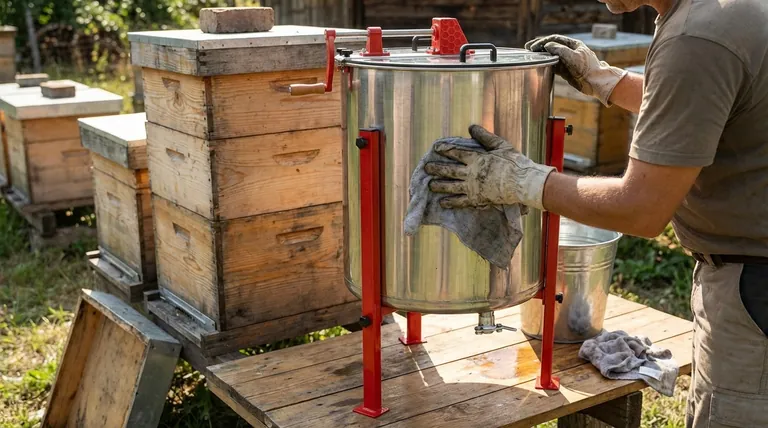The recommended method for cleaning the outside of a honey extractor is remarkably simple. All that is required is a damp cloth or rag and cool water to wipe away any dust, honey spray, or other residue. This approach is effective, fast, and ensures no contaminants are introduced that could affect your equipment or future honey batches.
Your primary goal when cleaning an extractor is not to achieve a "like-new" shine, but to maintain functional hygiene. The best method uses the simplest tool—water—to effectively remove residue without introducing contaminants or creating bigger problems.

The Standard Method: Simplicity and Water
The most effective cleaning strategy is also the most straightforward. For the exterior of your machine, aggressive methods are unnecessary and can be counterproductive.
Why a Damp Cloth is Sufficient
For routine cleaning, a damp cloth is all you need. Most residue on the outside of an extractor is simply dust or a light spray of honey from the extraction process.
A cloth dampened with cool or lukewarm water will easily dissolve and wipe away these spots. This prevents the need for any chemical cleaners or soaps.
Choosing the Right Water Temperature
Use cool or lukewarm water, not hot. While it seems intuitive that hot water would clean better, it can cause problems with honey extractors.
If any bits of beeswax are present, water above 120°F (49°C) can melt them. This doesn't remove the wax but spreads it in a thin film that becomes much harder to clean once it cools and re-hardens.
The Critical Rule: Avoid Contaminants
The most important principle in cleaning any beekeeping equipment is to avoid introducing substances that could taint your honey.
The Problem with Soap Residue
Using soap or detergents to clean your extractor is generally not recommended. Any soap residue left behind, even in trace amounts, can easily contaminate your next honey harvest.
The risk of compromising the taste and purity of your honey far outweighs any minor cleaning benefit soap might provide. Clean water is almost always sufficient.
When to Use a Mild Detergent
If you encounter an exceptionally stubborn spot of grime, you might consider a mild, food-safe detergent.
However, if you do, you must be absolutely meticulous about rinsing. Rinse the area thoroughly multiple times with clean water to ensure every trace of the detergent is gone.
Understanding Common Cleaning Mistakes
Avoiding common pitfalls is just as important as knowing the right steps. Many well-intentioned efforts can make cleaning more difficult or damage your equipment.
The Hot Water Myth
As mentioned, using very hot water is a frequent mistake. It complicates wax removal and is unnecessary for dissolving honey. Stick to cool or warm water for a much easier experience.
The Risk of Over-cleaning
Striving for a perfectly spotless, factory-new appearance is not the goal. Small scuffs or stains that don't come off with a basic water wipe-down will not harm the machine or your honey.
Focus on removing the actual honey residue and dirt. Once the extractor is clean and dry, keeping it covered will significantly reduce the cleaning effort required next season.
A Note on Pressure Washers
While some beekeepers use a pressure washer for the interior of the tank, it is generally overkill and risky for the exterior.
A high-pressure stream can damage the motor, gears, legs, or other working parts of your extractor. For external cleaning, the gentle approach of a damp cloth is always safer and more appropriate.
How to Apply This to Your Goal
Your cleaning approach can be tailored to the specific situation.
- If your primary focus is a quick wipe-down after extraction: A damp cloth with cool water is perfect for removing fresh honey spray and dust.
- If you are dealing with stubborn, dried-on honey: Use a cloth with warm (not hot) water and a little patience to dissolve the sugar.
- If you are preparing the extractor for long-term storage: Ensure the exterior is completely clean and dry to prevent rust and discourage pests.
Proper maintenance protects your equipment and your honey, ensuring quality for years to come.
Summary Table:
| Cleaning Step | Key Principle | What to Avoid |
|---|---|---|
| Use a damp cloth with cool/lukewarm water | Effectively dissolves honey and dust without spreading wax | Hot water, which can melt and spread beeswax |
| Wipe away residue | Maintains functional hygiene without harsh chemicals | Soaps and detergents, which risk contaminating honey |
| Ensure surface is clean and dry for storage | Prevents rust and protects your investment | Pressure washers, which can damage motor and gears |
Protect your honey harvest and extend the life of your equipment with the right supplies. HONESTBEE supplies commercial apiaries and beekeeping equipment distributors with high-quality, durable extractors and maintenance tools through our wholesale-focused operations. Let our expertise help you maintain peak hive productivity. Contact our team today to discuss your apiary's needs!
Visual Guide

Related Products
- 6 Frame Manual Stainless Steel Honey Extractor Beekeeping Equipment
- HONESTBEE 72 Frame Industrial Electric Honey Extractor for Beekeeping
- HONESTBEE 6 Frame Three Use Electric Honey Extractor for Beekeeping
- Plastic Hand Crank 2 Frame Honey Extractor Low Price
- HONESTBEE 3-Frame Manual Acrylic Honey Extractor
People Also Ask
- What is the relationship between beeswax harvesting and honey extraction? An Inseparable Process Explained
- Which type of extractor is more suitable for hobbyists or small-scale beekeepers? Find the Perfect Fit for Your Apiary
- How many frames can different types of honey extractors hold? Maximize Your Harvest Efficiency
- What tips can maximize honey extraction efficiency? Unlock Higher Yields and Purer Honey
- How long does it take to extract honey with an extractor? Plan Your Harvest for Maximum Efficiency



















